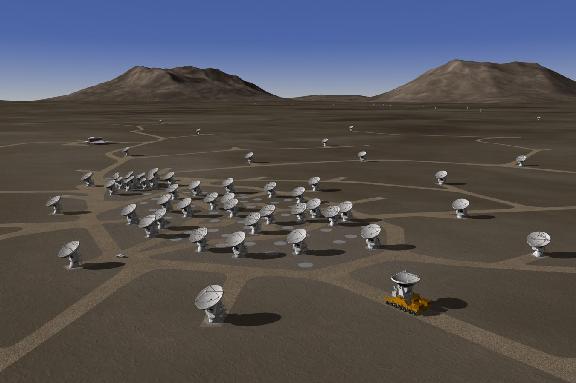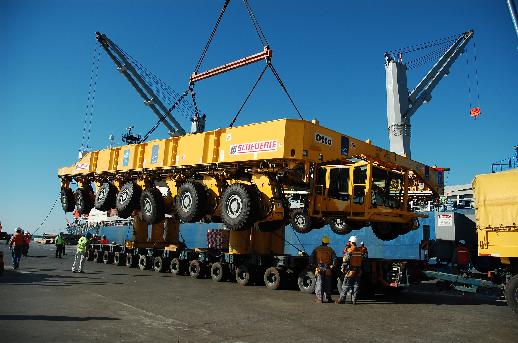EMBARGOED For Release: 1:45 p.m., EST, Friday, February 15, 2008
Contact:
Dave Finley, Public Information Officer
Socorro, NM
(575) 835-7302
dfinley@nrao.edu
World-Wide Effort Bringing ALMA Telescope Into Reality
In the thin, dry air of northern Chile's Atacama Desert, at an altitude of 16,500 feet, an amazing new telescope system is taking shape, on schedule to provide the world's astronomers with unprecedented views of the origins of stars, galaxies, and planets. The Atacama Large Millimeter/submillimeter Array (ALMA) will open an entirely new "window" on the Universe, allowing scientists to unravel longstanding and important astronomical mysteries.

Artist's Concept of Completed ALMA CREDIT: ALMA/ESO/NRAO/NAOJ Click on image for high-resolution file (182 KB) |
"Most of the photons in the Universe are in the wavelength range that ALMA will receive, and ALMA will give us our first high-resolution views at these wavelengths. This will be a tremendous advancement for astronomy and open one of our science's last frontiers," Anneila Sargent, a Caltech professor and ALMA Board member, told the American Association for the Advancement of Science at its meeting in Boston, Mass.
The millimeter and submillimeter wavelength range lies between what is traditionally considered radio waves and infrared waves. ALMA, a system using up to 66 high-precision dish antennas working together, will provide astronomers with dramatically greater sensitivity, the ability to detect faint objects, and resolving power, the ability to see fine detail, than has ever before been available in this range.
"This ambitious project is the product of an international collaboration that spans the globe," Sargent said. "ALMA truly will enable transformational science and providing this capability has required a massive, world-wide effort," she added.
The ALMA project is a partnership between Europe, Japan and North America in cooperation with the Republic of Chile. ALMA is funded in Europe by ESO, in Japan by the National Institutes of Natural Sciences in cooperation with the Academia Sinica in Taiwan and in North America by the U.S. National Science Foundation in cooperation with the National Research Council of Canada. ALMA construction and operations are led on behalf of Europe by ESO, on behalf of Japan by the National Astronomical Observatory of Japan and on behalf of North America by the National Radio Astronomy Observatory, which is managed by Associated Universities, Inc.

ALMA Antenna Transporter Arrives in Chile CREDIT: ALMA/ESO/NAOJ/NRAO Click on image for high-resolution file (808 KB) |
While scores of people are working at the ALMA site in Chile, more are in laboratories, test facilities, and factories around the world developing and producing equipment destined for ALMA. Antennas are coming from Europe, North America, and Japan. The giant transporter machines that will allow the antennas to be moved into multiple configurations have arrived in Chile from Germany. The prototype antennas and the prototype electronic equipment for ALMA have been tested at the site of the Very Large Array radio telescope in New Mexico. In Chile, buildings, roads and the complex infrastructure required to support ALMA operations all are coming together.
Groundbreaking for ALMA was held in 2003, and the project is scheduled for completion in 2012.
Astronomers expect ALMA to make extremely important contributions in a a variety of scientific specialties. The new telescope system will be a premier tool for studying the first stars and galaxies that emerged from the cosmic "dark ages" billions of years ago. These objects now are seen at great cosmic distances, with most of their light stretched out to millimeter and submillimeter wavelengths by the expansion of the Universe.
In the more nearby Universe, ALMA will provide an unprecedented ability to study the processes of star and planet formation. Unimpeded by the dust that obscures visible-light observations, ALMA will be able to reveal the details of young, still-forming stars, and is expected to show young planets still in the process of developing. In addition, ALMA will allow scientists to learn in detail about the complex chemistry of the giant clouds of gas and dust that spawn stars and planetary systems.
Many other astronomical specialties also will benefit from the new capabilities of ALMA, In addition, "We know that every time in the past that a new wavelength region has been opened up, as ALMA will do, we have been surprised by entirely unexpected discoveries that significantly changed our understanding of the Universe. We also expect the unexpected from ALMA," Sargent said.
The National Radio Astronomy Observatory is a facility of the National Science Foundation, operated under cooperative agreement by Associated Universities, Inc.
Modified on Friday, 15-Feb-2008 14:05:59 EST View ALMA Videos
View ALMA Videos